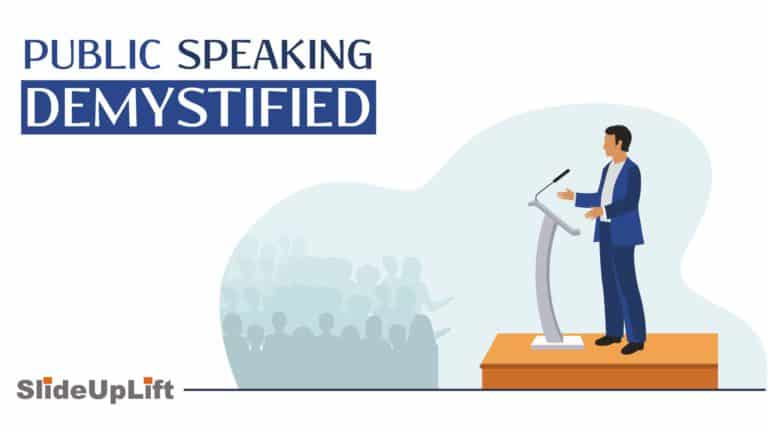
We live in a world where we are overwhelmed with content, and communicating information effectively to others is more important today than ever before. Public speaking is a great way of communicating at many levels, whether your goal is to engage in a debate, make a career as a speaker, or gain confidence in presenting to an audience. Public speaking is also a must-have skill for leaders, managers and a requirement for all entrepreneurs and business executives.
Most people often have little exposure to public speaking and therefore face anxiety and fear, which lead to poor performance. But with practice, they become better acquainted with the public speaking process, making them more confident and less apprehensive.
Today, we will take you through the most important steps to master the art of public speaking. Once you learn the basic skills associated with public speaking, you’ll realize that being able to speak confidently in public has profound benefits.
1) Laying A Roadmap
a. The key element of effective public speaking is a well-laid plan. If you want the audience to understand your content, it needs to have a clear and logical flow.
b. A well-laid structure will allow you to not get lost while preparing and save you time to formulate actually important points.
c. Start with figuring out your purpose for giving a speech. Preparing a Speech or presentation should move towards a well-defined goal.
d. It’s important to pick a topic that you are passionate about. This will inspire you to prepare effectively, and be more confident when you deliver.
e. As an added benefit, if you are excited and motivated about a topic, your energy will translate to the audience through the content.
f. Your intent and a mutual goal with the audience will make or break your communication. The more aligned you are towards their interests, the more chances you will be an effective speaker to them.
2) Getting Started In Your Mind
a. It’s up to you to decide how you think about the presentation. Is it a threat or an opportunity? Your attitude plays a key part in your success. The audience is coming here to hear what you have to offer and learn something.
b. Be authentic. You can not afford to lose your individuality and try to be someone you’re not. Don’t try to tweak your accent or stand in a pretentious manner. Being yourself is simple and that’s one less thing you need to worry about.
c. Great speakers usually have a strong foundational belief in their knowledge and expertise. Change your thoughts, change your outcome! Simply thinking about giving a successful presentation will increase the chances of success and give you confidence.
3) Prepare Good Content
Imagine yourself presenting the business plan for a product worth billions of dollars to a board of an organization. In other words-a high stakes situation. You will need to prepare for such a presentation- thinking of the pitch, the story flow, the objections that can arise, fears, uncertainties, doubts in the audience’s mind. You would want to preempt such objections using compelling, masterful content. Following are the steps that’ll help you through-
a. Develop a detailed view that lays out all the key stakeholders involved, their areas of expertise, their circle of influence, and your understanding of what your content offers them. List down what is in it for them, what concerns them, and what would inspire them.
b. Everyone prefers a certain medium or style such as visual, auditory, or tactile. Build your presentation with these learning styles in mind. Remember, you have to bring your audience over to your side to endorse and support this new idea or concept. Use visually appealing powerpoint templates to build engaging presentations. Or you can try ready to use powerpoint themes as a starting point in building your visually engaging content.
c. To conclude this point, focus on the three Cs. Your content should be Crisp, Concise, and Cohesive.
Examples of good presentation slides
Source: 30 60 90 Day Plan Template by SlideUpLift
Source: Animated Business Strategy by SlideUpLift
To summarize, your content should be visually appealing and eye-catching. Make your presentation short, crisp, and engaging. Learn the best practices in building the content for your speaking engagement.
4) Master The Physical Presence
Practice your nonverbal mannerisms as well as your words.
a. Much of your credibility depends on how you sound and how you look. Stand in the “ready position” distribute your weight evenly on both feet, and hold your arms comfortably at your sides.
b. You can send a strong message of confidence to any audience by standing tall. When you sit to present, you can send the same message by rolling your shoulders back and sitting tall.
c. Dress to match the situation. If you are too formal, you can be perceived as intimidating. If you dress too casually, you can lose credibility.
d. The audience prefers good eye contact, too. If you’re particularly nervous about looking people in the eye while you’re speaking and you have the opportunity to speak before a large audience of twenty-five or more, look people in the forehead.
5) Practice
There’s a good reason that our forefathers said, “Practice makes you perfect!” You simply cannot be a confident, compelling speaker without practice.
a. If you’re going to be delivering a presentation or prepared speech, create it effectively and ahead of the big day. The earlier you put it together, the more time you’ll have to practice.
b. Practice it plenty of times in front of a mirror, using the presentation you’ll rely on at the event, and, as you practice, tweak your words until they flow smoothly.
c. Then, if still needed, do a dummy run in front of a small audience, fellow employees, or even friends and family. This will help you calm your nerves and make you feel more comfortable with your content.
In conclusion, most of us have the ability to speak, however, to be a successful public speaker you really need to master it via thoughtfulness and practice. There is no doubt that the art of public speaking requires effort – a combination of facing your fears and persistence. However, by adopting the right practices, you’ll improve your ability to positively impact your audience and make them feel fulfilled with your performance.
Once you’re ready with compelling content, breathtaking visual design, and mastery in body language it eventually comes to you. You take the center stage, deliver your idea to your audience, and receive a roaring ovation!
Now you don’t have to scour the web to find out the right templates. Download our PowerPoint Templates from within PowerPoint. See how?








![Best professional powerpoint examples Best Professional PowerPoint Examples For Presentations [Premium Templates]](https://slideuplift.com/wp-content/uploads/2023/08/Best-professional-powerpoint-examples.jpg)
![How to make a flowchart in google slides How To Make A Flow Chart In Google Slides [Quick Flow Chart Guide]](https://slideuplift.com/wp-content/uploads/2021/11/How-to-make-a-flowchart-in-google-slides.jpg)